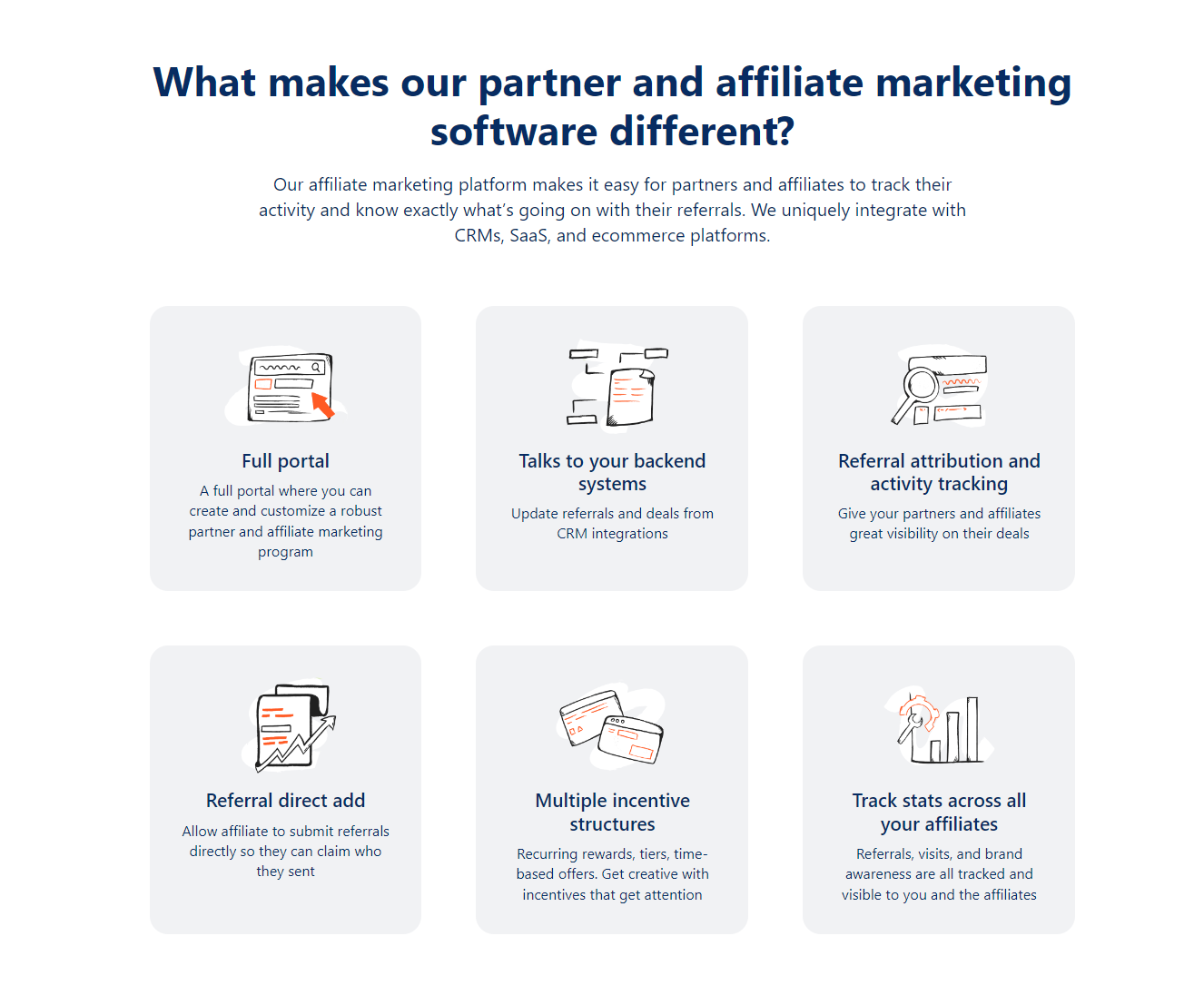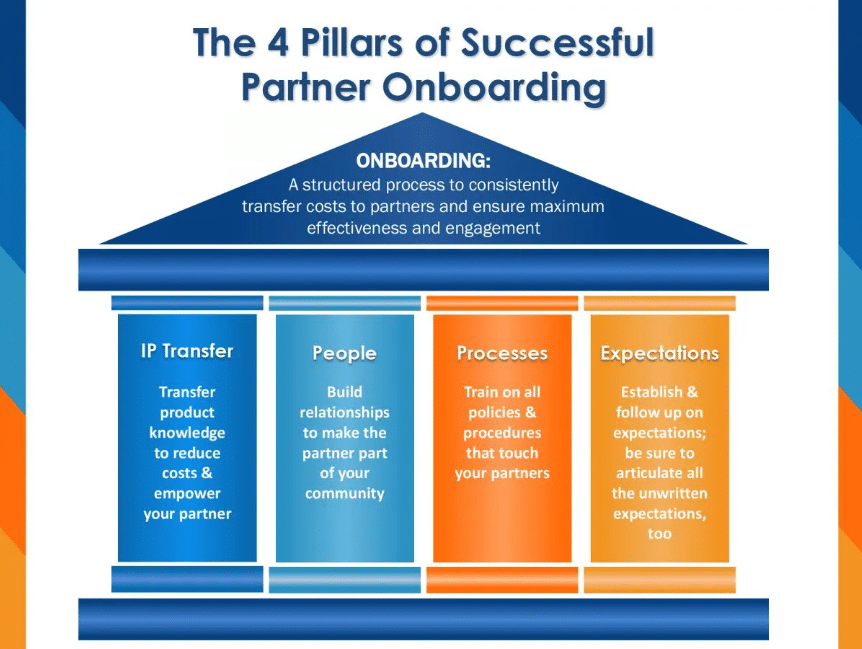Partnership management is a crucial skill for any business ecosystem to thrive in today’s interconnected world. Effective partnership management involves identifying, building, and maintaining relationships with key partners, such as suppliers, distributors, customers, and other stakeholders. This requires a deeper understanding of the needs and goals of each partner.
This post will cover some of the key skills and strategies essential for successful partnership management. Also, it provides practical tips and examples to help you improve your partner management skills.
What is a partnership manager?
A partnership manager is a person responsible for managing all aspects of a partnership (an agreement between two businesses – or a business and individual – to promote each other through sales, distribution, or marketing efforts).
The partnership manager is essentially the liaison between both parties, and is your brand’s representative within the partnership. They’re the point of contact for the partnership at your business – the person your partner can come to with any questions.
The role of a partnership manager is to ensure that both partners are aware of their responsibilities and rights, as well as any changes that might arise within the partner relationship. They’ll oversee the partnership’s progress and consult with the partner on how to proceed based on data. Managing the partnership isn’t necessarily their only role at the company, but it’s one of their key responsibilities within marketing and/or sales.
What does partnership management involve?
Strategic partnership management involves various tasks. Here are some of the main ones:
- Partnership managers work with the partner to set goals and outline the responsibilities of each party. This ensures everyone understands their respective duties and avoids confusion or conflicts.
- They train partners on how to promote their brands effectively. This consists of providing marketing materials, training on products or services, and guidance on how to communicate with potential customers.
- They convey information between their business and partners to maintain a successful partnership. Partnership managers act as a liaison between their organization and its partners. They ensure everyone is up-to-date on vital information, such as changes to product offerings, marketing campaigns, and other updates.
- They are responsible for paying partnership incentives and ensuring partners receive other partnership benefits. For instance, they’ll manage the payment of commissions, bonuses, and other partnership rewards.
- Partnership management also involves checking in with the partner directly and regularly and examining their collective progress on accomplishing the partnership’s mutual goals. Partnership managers analyze performance data, evaluate the effectiveness of partnership strategies, and identify areas for improvement. This helps ensure the partnership remains focused and productive.
Key partnership management skills
For a partnership to be successful, every partnership manager should be equipped with the following skills:
Communication skills
Communication skills are vital for partnership managers, as they are required to write and speak with their partners on different topics. For instance, they’ll need to negotiate contracts and discuss ideas for future projects.
Written communication skills are needed when sending emails or letters to partners, to best inform them about important issues. And verbal communication skills are necessary during face-to-face meetings with partners.
In addition, interpersonal and active listening skills are essential to allow partnership managers to work well with others and set goals together. These all-important skills also help you understand partners’ needs more effectively. For instance, suppose one of your partners has an issue that needs resolution; then it’s important to understand what the problem is and provide a quick solution before further damage. Empathy – the ability to see things from your partner’s point of view to best meet their needs – is also crucial.
Management skills
The ability to influence and persuade others is a key skill for partnership managers. In addition, you need to lead and motivate your team by ensuring everyone in the partnership is aligned on goals and objectives.
Organizational skills are vital to set mutual goals, determine who needs to do what in what timeframe, prioritize tasks, and ensure responsibilities are accomplished. You’ll need to develop an action plan outlining how your goals should be achieved, and organizational skills will help you create this plan and delegate tasks within it.
Adaptability in a fast-paced environment
Partnership managers must be able to adapt to any change, whether it’s a new client request or an unexpected challenge arising within their partnership teams or organization. In addition, partnerships are constantly evolving. Therefore, you need to be flexible with new ideas and concepts, while maintaining established relationships with clients and other partners.
Creativity
Creativity for combining the strengths and assets of each party in the partnership into one super-strong team is important. It means thinking outside the box when accomplishing goals and solving problems. You need to be open-minded to consider ideas your partner might have, as this may well help you achieve success faster than if you were working alone.
Creative skills are also needed for developing partner marketing and sales strategies. This is among the top steps in developing a strong relationship with partners. The ability to communicate effectively with customers requires a good understanding of their needs. This can be done through email, phone calls, and social media. At the same time, creativity helps in figuring out how to build trust and rapport with customers. And this could directly lead to sales or help you to be seen as an expert in the industry.
Analytical skills
Data analysis skills are needed to both plan the best course of action for a partnership and check how the partnership performs. Partnerships are built on trust, and trust is built on good communication. The more you understand your partner’s business, goals, and challenges, the better you work together.
You need to gather information about your partner ‘s business when entering into a partnership, so you can synthesize their strengths with your own. This should consist of your partner’s structure, history, current culture, current marketing strategies, and more. Also, consider conducting a SWOT analysis (strengths, weaknesses, opportunities, and threats) to identify opportunities for collaboration.
Once the partnership is up and running, you’ll need to study data on sales and conversions, as well as other vital metrics. This way, you’ll know what’s performing well and what tactics need refining.
Essential partnership management strategies
Partnerships are a great way to grow businesses’ revenue and expansion. However, sometimes they fail because they lack the necessary elements for success. Below are six strategies to improve your partnership management.
1. Set mutual goals together, and discuss how you’ll achieve them
In order to ensure successful partner collaboration, it is crucial to set mutual goals as the foundations of your partnership management strategy. These goals should be specific objectives that cannot be achieved by either organization alone, but require joint efforts to accomplish.
Therefore, setting common goals needs a deep understanding of what each partner brings to the table. This involves identifying what the partner can accomplish, like reaching a new market or opening up a new distribution channel.
Next, talk about how you’ll achieve the goals you’ve set:
- What are the partner’s core duties and expectations?
- What will you accomplish for the partner, and how?
- What distribution channels will the partners use?
- How will your and your partner’s offerings (say, your products, services, expertise, and/or relationships with an audience) add value to each other?
In order to measure your progress towards your goals, it’s vital to establish measurable, time-bound KPIs. For instance, you might track sales amounts, new leads, conversion rates, or other metrics relevant to your partnership objectives. By doing so, you can assess how well you’re achieving your goals and what adjustments are needed to stay on track.
2. Nurture partner relationships
Nurturing partner relationships can build trust, foster collaboration, and strengthen the overall partnership. Therefore, it’s important to understand your partner’s skills, strengths, interests, needs, and challenges.
One way to do this is by connecting with your partners on a human level, rather than just on a business level. It’s vital to take time to know your partner on a personal level and understand their values, goals, and motivations. By doing so, you’ll build a more meaningful and productive relationship.
Regular discussion of needs, ideas, and challenges with your partners in open conversations is also important. This involves creating a safe and open environment where both parties readily share their thoughts and ideas. Furthermore, it’s important to be responsive and proactive in meeting your partner’s needs. This will show them your commitment to the partnership.
3. Use PRM software to make partnership management easier
Partner relationship management (PRM) software helps you manage all aspects of your partnership relationships. It tracks partnership sales through custom links and aggregates partner data for you in real time, so you always know how your partnership is performing. It instantly pays out incentives to partners when they make sales, and can even boost partner engagement with strategic messages.
PRM software works in a uniform way, making it easier to keep track of key information for each partner. Plus, it lets you create a partner portal and provide training materials, information and assets to partners at any time. It also provides tools for managing day-to-day partnership activities, for instance, handling quotes and responding to requests from partners, among others. So, it makes communicating with partners easy.
Referral Rock offers PRM software that’s flexible enough to track and manage all partnership types.
4. Onboard and train partners
Onboarding and training new partners is another critical step in your partnership management strategy. This ensures your partners are equipped with the knowledge and tools needed to effectively promote and sell products or services.
For effective onboarding and training, consider the following:
- Identify the channels you’ll use for onboarding. For instance, you might use Zoom, asynchronous videos, or your partner portal.
- Single out the key info that partners need to market/sell your products, including unique selling points and how to use the products.
- Also, establish standards for how your brand should be represented – how partners should and shouldn’t market and sell your products or services. This should contain guidelines on messaging and rules for the promotion.
- Provide your partners with tools, assets, and resources for success. For instance, give them product information, product images, videos, and whitepapers. Your partner portal is a great place to keep these assets easily accessible.
- Provide information on how partners can effectively use the portal and share their partner links.
- Make payment terms clear – specify the incentives and what must be done to earn them. This will motivate partners to promote and sell the products or services effectively.
- Once you’ve established all of these terms, have yourself and your partners sign a written partnership agreement, where you both consent to all terms of the partnership.
5. Keep the lines of communication open
It is essential to establish strong communication channels with partners that encourage them to reach out with any questions, concerns, or feedback they may have. There are many ways a brand can effectively communicate with its partners. For instance:
- Providing a dedicated point of contact that partners can reach out to directly (usually, this will be your partnership manager). This person should be available to address any issues, provide updates, and offer guidance as needed.
- Holding regular check-ins. This can be done through phone calls, video conferences, or in-person meetings. This ensures brands are on the same page as their partners and any issues or concerns can be addressed in a timely manner.
- Using collaboration tools like Slack, or other project management software, can also keep partners informed and engaged. These tools allow automation for real-time updates and discussions, making it easier for partners to stay up-to-date on the latest happenings (like new product releases or new partnership incentives) and offer feedback.
Remember that partnerships are a two-way street – regular, collaborative discussions about needs and challenges are key for a healthy partnership.
6. Regularly analyze partnership data
Regularly analyzing partnership data helps to identify trends, and helps in decision-making about how you should proceed with the partnerships. You can use this information to evaluate whether the partners are meeting their obligations, as well as receiving the benefits expected. By paying attention to these metrics, you’ll identify any issues during your partnership program and can take action before they worsen.
Set up regular performance reviews where you check and analyze partnership data (this could be during every check-in or during other dedicated times). Then, use this data to plan the best course of action together – what’s going well in the partnership? What needs improvement? Partners should also have access to this data anytime they want it, through your partner portal created with PRM software
You should track and analyze sales generated through the partnership, leads generated, customer base growth, and conversion rates in given time frames. But you can also track other metrics that you and your partners decide on
Wrapping up
If you’re looking for a partnership that will truly benefit both parties, it’s vital to be honest, and clear about your expectations. If you communicate well and set boundaries in advance, you’ll greatly increase your chances of success.
The collaboration will make team projects run more smoothly, and partnerships can yield opportunities that neither party would otherwise have access to. So what are you waiting for? Implementing these partnership management tips will help you produce amazing results!






